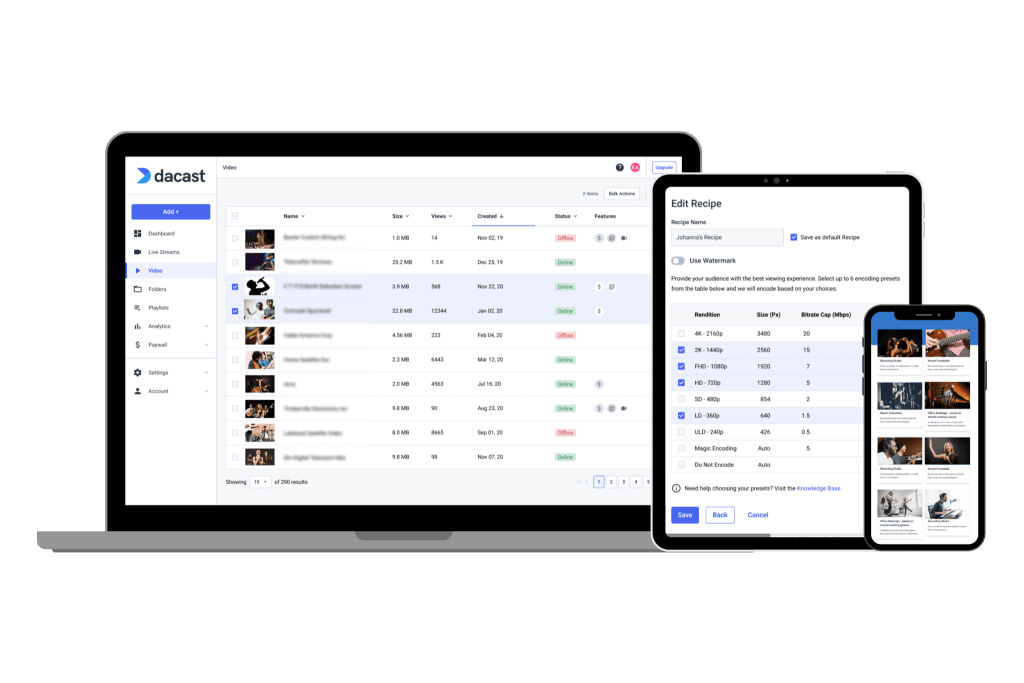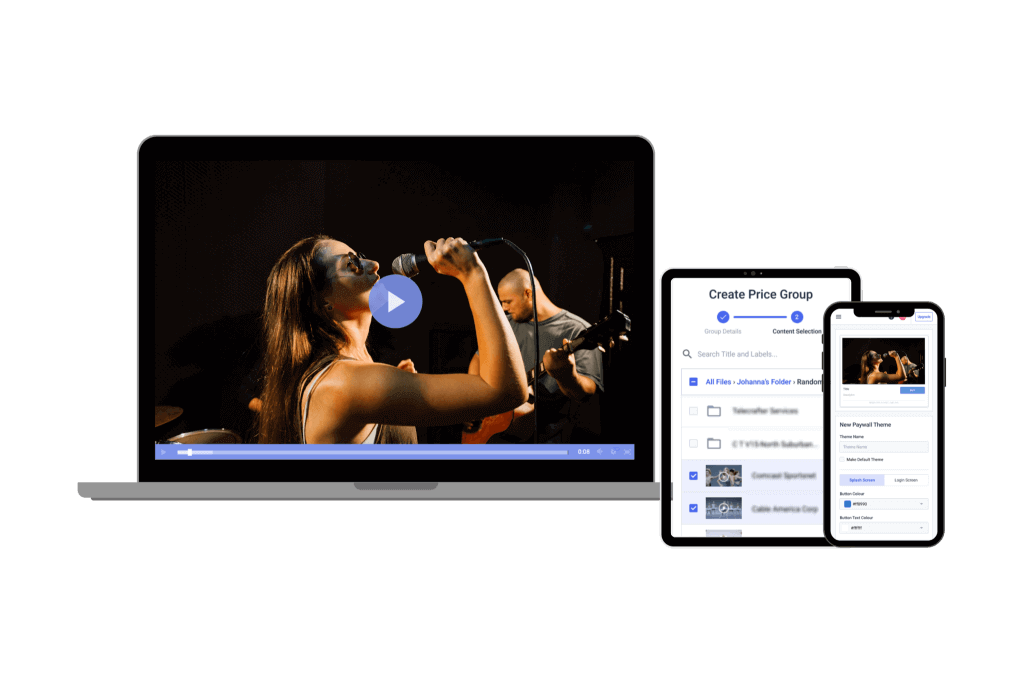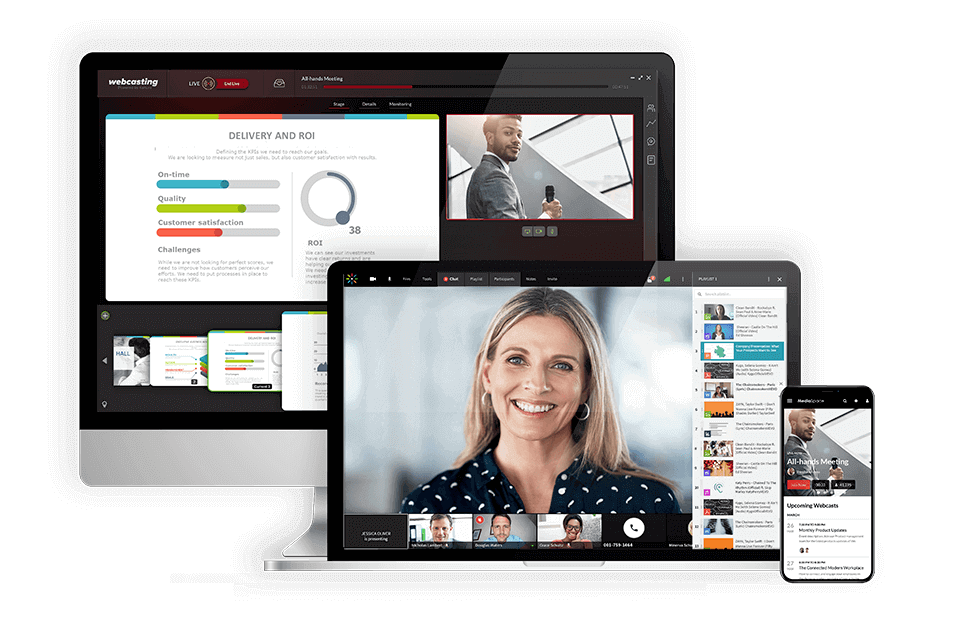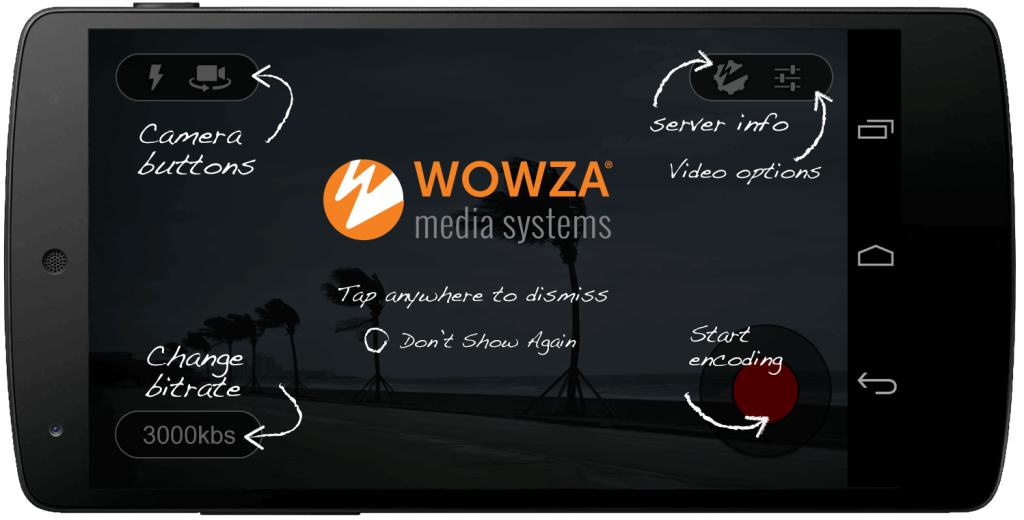What is a Video Content Management System (CMS) and How to Choose One for Your Business
In the ever-evolving digital landscape, businesses are always looking for new ways to create videos that are interesting and informative and that will connect with their audience.
How many times a day do you use your mobile device to look something up? Your search results likely contain as many video results as they do written content. The influence of video content on overall online user behavior grows annually. For example, YouTube boasts that its platform watches one billion hours of video daily, translating into billions of individual video views daily.
Creating, storing, organizing, and monetizing compelling video content is essential to the growth and success of creators. To manage all these important tasks and maintain video quality, broadcasters are turning to video content management systems to help them reach their video monetization and distribution goals.
In this post, we will discuss what a video content management system is and what to look for in a video CMS. We will review 10 of the best video hosting CMS options for broadcasters looking for a well-rounded streaming experience.
Table of Contents:
- What is Video Content Management?
- What is a Video Streaming CMS?
- How Does a Video Content Management System Work?
- What Are Examples of Video Content Management Platforms?
- Key Features of Enterprise-Grade Video CMS
- Conclusion
What is Video Content Management?

Video content management systems are the process of organizing and managing your media content, including videos, text, and graphic imagery, in the most efficient way possible. Still, it takes care of many smaller details related to overall video performance as well. CMSs can automatically adjust video quality to reduce buffering, make video tags easily searchable, create playlists, and manage video and digital content.
This content is stored in a video content management system (CMS), designed for easy access to your content.
A content management system isn’t an unfamiliar concept to most of us. Imagine when you wanted to show a friend an old photo saved to your phone. To access it, you had to go into the image management system on your phone, which might be as simple as a folder called “Photos.”
So, what is a video CMS? It’s where your videos are stored and organized, where you can access them in the future for whatever you need them. A CMS for video content could be a simple folder or a much more powerful tool.
What is a Video Streaming CMS?
Video content management systems also often referred to as a video hosting CMS or a video CMS, is a specific type of content management system. Rather than storing and organizing various media types, a video CMS platform is meant solely for use with the hosting and streaming of video files.
A video content management system includes features that allow you to search and sort by various keywords and data points to find what you need faster.
A video content management system serves as a library for your created videos. It has a basic search function that allows you to find the information you need through video search. It allows you to embed videos, group videos together, or use bulk commands. Some video CMS also offers a video API feature that allows you to build your content management system how you want it.
Hosting all your video files in one central location makes storage and organization easier, and it makes it easier to distribute your videos live and on-demand channels.
How Does a Video Content Management System Work?

At its most basic, a video CMS hosts, stores, categorizes, and organizes video content. It provides a central place to house all your small and large video files, both RAW and edited, and see key information about those files.
A video CMS uses specialized video management software to host, store, and label video content, allowing you to search and stream your entire library of files to find exactly what you’re looking for.
Let’s say you’re looking through your CMS for a video podcast you recorded on tips for entrepreneurs looking to start a new business. A CMS allows you to type in a keyword (“Entrepreneur tips,” for example) and presents you with all the video clips you have uploaded with that combination of terms attached.
A CMS for streaming video also has viewer-facing capabilities.
Suppose a viewer is watching that same video podcast about tips for entrepreneurs looking to start a new business. In that case, the streaming CMS analyzes the metadata on that individual video and combines your collection with other similar videos to suggest.
It’s a win-win scenario where your audience gets more of the content they are looking for without having to work for it while you reap the benefits of increased viewership and longer watch periods.
Key Features of Professional-Grade Video CMS

Not all video CMS are created equal. Some are good for beginner users, with their easy-to-navigate platforms and step-by-step instructions. For the more advanced user or someone producing a lot of content, a lower-level video CMS platform going to do the trick.
If you need robust video CMS streaming software with ample upload and storage options, a professional-grade video hosting CMS will be your best video CMS choice.
Enterprise video CMS platforms allow a more customized amount of features to meet the needs of professional business usage. Determine what features you need in a video CMS and find an online video platform that offers everything you’re looking for.
Batch Uploading Tools
Uploading your video files can be incredibly time-consuming, causing you to spend hours just getting one video ready to publish.
With bulk uploading tools, you can securely and efficiently upload multiple video assets into the CMS. That decreases the time you spend getting your videos ready and decreases the amount of bandwidth you need to process all these uploads.
Many video CMS platforms offer one or more options for bulk uploading tools, including
- Bulk upload option: This tool allows you to select multiple video files to upload at a time, and extra features, such as auto pause and resume, help protect you from frustrating unstable wifi connections.
- Dropbox integration: Some platforms, such as Dacast, have an integration that allows you to drag and drop your video assets into a special Dropbox folder without ever opening a browser. From there, the files are accessible inside the CMS, saving you storage space and bandwidth.
- FTP upload: FTP, or file transfer protocol, uploading allows for secure, fast video uploading through a client. The client connects to the FTP server, and you send your files for storage and use.
- Video library migration: If you’ve already got an extensive video library hosted on another video CMS platform, some video CMS software allows you to do a batch transfer of all your files.
Cloud Transcoding
When you film a video, it’s not always captured in a size suitable for viewing. Viewing a video on a mobile device may require a different file size than on a desktop computer, which is likely different from your camera’s file size when recording the video.
A professional-grade video hosting platform should have a built-in feature that automatically converts uploaded video files into various formats, allowing videos to perform their best on various devices.
Cloud transcoding tools also make it possible to stream video with an adaptive bitrate video player. This type of streaming sends the optimal rendition of the stream to each viewer based on their internet speed.
Video Organization
Having your videos well-organized and grouped logically is key to video management and helping your viewers find what they’re looking for easily. Grouping related videos together also help users find videos similar to those they’ve already watched, giving them deeper insight into a topic and keeping them watching your videos longer.
Some of the key things to look for when selecting a video streaming CMS include:
- Categories and subcategories for any organization: This feature allows you to group all your videos on business budgeting together, for example, and then to further group those budgeting videos into smaller, more niche subcategories.
- Tagging: Adding tags to your videos allows them to be searchable by viewers interested in seeing everything on one subject. They can be used across categories to related videos that otherwise wouldn’t be grouped.
- Smart playlists: Many users find their digital world overwhelmed by too much content, making it all difficult to sort through. With a smart playlist feature in your video CMS software, users can create automatic playlists of videos that adhere to certain rules, such as being related to a specific keyword, giving them an auto-generated group of videos to begin watching.
A superior video hosting CMS platform will offer all the above features for video organization, plus some more advanced tools.
Dacast, for example, supports two levels of subcategories, allowing you to group like videos and help your viewers find the videos they will enjoy the most. Dacast is one of the few video CMS platforms with a contract to host video in mainland China, opening your content up to a whole new audience.
Video Privacy & Security
Protecting your videos is of the utmost importance. You need to be able to upload videos as well as store and share videos privately without worrying about them being compromised. For example, many companies need a secure video management system for secure viewing, video sharing, video conferencing, video hosting, and management of their t raining videos.
Securely upload and share videos with HTTPS uploading and delivery. That lock in the corner of the address bar shows your data is safe and gives your viewers peace of mind that their devices won’t be bogged down by malware when they visit your videos.
In addition, a good video CMS should include AES encryption, DRM encryption, or both.
Keeping your videos from getting spammy views is crucial. Your video CMS can restrict specific domains or IPs to limit the possibility that spammers and pirates will target your videos.
Monetizing your videos is also important, and if you offer subscription services or other formats where your viewers pay for access, your video CMS must offer password protection or a paywall integration. This allows you to require a password to view your content, making sure only the people who have paid to see your videos get access.
Video API Access
Video API access is essential for customizing your video hosting and content management experience. API access lets you integrate the features you need most from a video hosting CMS into your own platform, allowing you total control over your content and how you share it.
Many businesses have taken advantage of the white-label option for Dacast, which was voted Best Small/Medium Business Platform in the 2019 Streaming Media Readers’ Choice Awards.
When you’re ready to take your video streaming mobile, software development kits (SDKs) allow you to easily integrate your CMS into iOS and Android apps.
Video Monetization
If your business model depends on video monetization, choosing a properly-equipped streaming CMS is key to making the process easier for you.
When selecting a video CMS software that includes monetization features, you want something that offers a built-in video paywall that’s also secure.
Take Dacast, for example. The video content management platform has an SSL-secure integrated paywall, so you can monetize your videos without the worry that your customers’ credit card information and personal data will get stolen.
Having a variety of monetization options and integrations is also important, so you don’t have to struggle to make your chosen method of making money fit into your video CMS’s options.
The best video CMS will have support for three major monetization models:
- Pay-per-view (TVOD) support allows you to charge every time a viewer watches a piece of your content. If you have exclusive rights to a piece of valuable content, you can charge for every view of your concert, conference, or other broadcast. Some examples of pay-per-view content include sporting events streamed from a league’s website, video pages, or a movie studio offering streaming access to a hot new release.
- Subscription (SVOD) support allows your subscribers to pay a set amount per time period (typically monthly or annually) to access your content. Streaming solutions such as Disney+ and Hulu are examples of the SVOD monetization model.
- Advertising (AVOD) support allows you to integrate sponsored advertising into your content and receive compensation by generating ad revenue. The most well-known example of the AVOD monetization model is YouTube advertising.
Some video content management systems offer extra options to help you further customize your video monetization, including offering coupon codes or creating packages to sell bundled content.
This extra flexibility gives you more opportunities to monetize your content in the best way for your business model.
10 Best Video Hosting CMS Options
An online video management system comes in all shapes and sizes. Some are better for smaller content creators, and others are geared toward those who want to create, share and monetize a large body of work.
Each of these video CMS platforms allows users to store, organize, and share their content with a variety of viewers. So which is the best video content management system? The streaming platform that is right for your business depends on matching up your needs and goals with the features of the video hosting CMS.
That said, let’s take a look at the 10 best video hosting CMS options on the market.
1. Dacast

Dacast is a video CMS that supports streaming of both live and private videos and on-demand video hosting. Dacast is one of the best video CMS options equipped with all of the tools broadcasters need for a well-rounded, professional video hosting experience.
Key Features:
- Video CMS functions for organizing libraries of 10,000+ videos
- Bulk video uploading
- Managed video migrations
- Robust video security features (AES encryption and IP restrictions)
- Advanced video and player API access
- Support for video monetization (AVOD, TVOD, and SVOD)
- 24/7 customer support is available via phone and email
- Access to advanced video analytics
- LMS Learning management system integration with Zoom live streaming
- Expo galleries video portal
- Adaptive multi-bitrate streaming
- Cloud-based video transcoding
- Ad-free streaming
Pros:
- Reliable video management
- Secure video sharing
- VOD and live stream hosting
- Business video hosting in China
- Mobile device support
- Live stream recording
- Detailed analytics
Cons:
- A minor learning curve for using all of the video management tools
Upload Guidelines and Specs:
- Minimum dimension: None (but 240p is the recommended minimum)
- Maximum dimension: 1080p or 4K (depends on the user’s hardware and internet)
- Aspect ratio: No restrictions (but 16:9 is the default)
- Max file size: None
- Max video length: None
- Total file storage: 10-1000GB (depends on plan)
- Compatible video formats: MP4 (preferred), MOV, M4V, M2V, AVI, MPG, FLV, WMV, MKV, WEBM, OGV, MXF, ASF, VOB, MTS
Price:
Dacast offers three standard pricing plans in addition to the option to custom high volume plans:
- Starter Plan: $39 per month:
- 1,000 GB of bandwidth
- 50 GB of storage
- Event Plan: $63/month:
- 6 TB of bandwidth upfront
- 50 GB of storage
- Scale Plan: $188/month:
- 24 TB of bandwidth per year
- 1 TB of storage
Also, Dacast offers many features in its Starter Plan that competitors only offer at higher pricing plans, if at all. Higher bandwidth options are available with custom plans. Dacast offers a free 14-day trial to each new user, so you can test drive the software and choose the pricing solution that best meets your needs right now.
To find out the best video CMS for you, please check out our bandwidth calculator.
2. Brightcove

Brightcove has been a trusted video streaming manager for nearly two decades. This video hosting platform offers three distinct types of enterprise video content management plans geared toward content management for monetization, marketing, and enterprise communications.
Each plan is custom-priced and offers different features and integrations to support users in search of each specific solution.
Key Features:
- Global video delivery
- Integrations for advanced video hosting CMS
- Support for security
- Full API Access
- Support for video monetization (AVOD, TVOD, and SVOD)
- White-label HTML5 video player
- Ticket-based tech support is available
- Detailed analytics
- Cloud video transcoding tools
- Audio descriptions
Pros:
- Customization with different integrations
- Professional video hosting experience
- CRM integration available for team collaboration
Cons:
- High pricing
- No support for China video delivery
Upload Guidelines and Specs:
- Minimum dimension: Determined by the user
- Maximum dimension: Determined by the user
- Aspect ratio: No restrictions (since Brightcove uses a responsive player)
- Max file size: No limits on files size
- Max video length: No published limits
- Total file storage: Varies by plan
- Compatible video formats: MP4, MOV, FLV, AVI, WMV, MKV, 3GPP
Pricing:
Since Brightcove offers several custom-priced streaming plans at high price points. These plans are geared towards enterprises and other advanced broadcasters.
No pricing is available on the website, but the different plans include
- Starter: includes 50 to 200 videos, up to 100,000 plays, and 2-5 users
- Professional: unlimited videos, 100,000+ plays, and no overages plays, with +10 users
- Enterprise: unlimited videos, 100,000+ plays, and no overages plays, with 10+ users, unlimited upload, and analytics-only users
Interested broadcasters can contact their sales department to receive a quote or sign up for a 30-day free trial.
3. IBM Video Streaming

IBM Video Streaming, formerly known as UStream, is one of the market’s most reliable and secure video-sharing CMS options. This platform supports both live video and o n-demand video streaming, and it is pretty expensive relative to the features it supports.
Key Features:
- Video content management tools
- Playlists for video organization
- Support for workflows and video distribution
- Engagement tools
- Ad-based video monetization
Pros:
- Live and VOD hosting
- Support for advanced streaming needs
- Reliable customer support
Cons:
- Does not use an external CDN
- Access to the platform via APIs is only available on custom-priced “Media and Enterprise Plans”
- Limited monetization support
Upload Guidelines and Specs:
- Minimum dimension: 480p (480 x 270)
- Maximum dimension: 4K (3840 x 2160)
- Aspect ratio: No published aspect ratio
- Max file size: 4 GB
- Max video length: No published limits
- Total file storage: 1TB – 5TB (depends on plan)
- Compatible video formats: MKV, MP4, MOV, FLV, AVI, WMV, MPEG2, H264, H263, MPEG4, VP6, VP8, THEORA, WMV, MP3, AAC-LC, NELLYMOSER, PCM, SPEEX, VORBIS, WMA
Pricing:
Pricing plans on IBM Video Streaming range from $99/month to $999 per month. These plans are broken down into the following:
- Silver – $99/month: 100 viewer hours, five channels, and 1 TB video storage
- Gold – $499/month: 2,000 viewer hours, ten channels, and 2 TB video storage
- Platinum – $999/month: 5,000 viewer hours, 20 channels, and 5 TB video storage
- Custom – Please contact IBM Cloud video for custom plan pricing.
Password protection comes with all plans. The $499/month plan adds embed restrictions. The $999/month plan includes full embed controls and a private channel URL.
4. JWPlayer

JW Player’s original technology has contributed to the development of the video streaming industry.
JW Player began as a video player, but today it is a platform equipped with video content management capabilities. This video hosting CMS was founded in 2005 as part of a student project, but today, JW Player offers video hosting services and live streaming.
This solution is known for its HTML5 video player for VOD content. In addition, JW Player is now a full-service live streaming provider.
Key Features:
- Live streaming and VOD hosting
- Tools for monetization (ad-integration)
- Detailed revenue tracking and analytics tools
- Multi-bitrate and adaptive streaming via cloud transcoding
- Global content delivery
- Video API access for customization
- Basic security features
Pros:
- Reliable HTML5 video player
- CMS platform is straightforward to use
- Good advertising tools
Cons:
- Limited live streaming capabilities
- Only ad-based monetization
Upload Guidelines and Specs:
- Minimum dimension: 360p (640 x 360)
- Maximum dimension: 1080p (1920 x 1080)
- Aspect ratio: 16:9, 4:3, 2.39:1
- Max file size: 25GB
- Max video length: Not available
- Total file storage: 25GB to 500GB (depends on the plan)
- Compatible video formats: MP4, WMV, AVI, MOV, 3GP, FLV
Pricing:
JWPlayer offers the following three pricing plans:
- Free trial: JW Player offers a 30-day free trial subscription which includes full API and SDK access, a non-commercial license, 25 GB hosting bandwidth, and 75 GB streaming.
- Starter plan: Starting at $10 per month, the Starter pricing plan includes an HTML5 Video Player, a video gallery 150 GB hosting bandwidth, and 500 GB streaming (50,000 plays) per month (billed annually).
Enterprise plan: these business-specific plans are available with custom pricing for high-volume storage and streaming. Enterprise plans support live streaming, while lower-tier plans only support VOD.
5. Kaltura

Kaltura is a self-hosted video streaming manager that uses an open-source format to allow broadcasters to customize their streaming experience, even with limited programming knowledge.
However, the customizability of this platform can make it a bit difficult to use. Since you can swap out every “part” of the platform, it is very complex and unsuitable for beginners.
Above all, Kaltura provides video hosting and management support for businesses and educational institutions.
Key Features:
- Open-source nature allows you to build your own video CMS
- Customizable with APIs
- Tools for organizing content, publishing, tagging, and more
- Partners with a variety of powerful CDNs
- Video security tools (DRM, encryption, and more)
- Monetization via integrated tools
- White-label video player is customizable
- Wide range of analytics tools
- Easy to export data
Pros:
- Customizable video CMS
- Flexibility on features due to support for integrations
- Well-suited for enterprise-level broadcasting
Cons:
- Complex pricing structure
- Can be overwhelming and difficult to use
- Not well-suited for businesses and broadcasters new to streaming
- Slow, ticket-based tech support
Upload Guidelines and Specs:
- Minimum dimension: 180p (320 x 180)
- Maximum dimension: 1080p (1920x 1080)
- Aspect ratio: 16:9, 4:3
- Max file size: 2GB
- Max video length: Not available
- Total file storage: 10GB to Unlimited (depends on the plan)
- Compatible video formats: MOV, MP4
Price:
Kaltura uses a token-based pricing structure that allows users to spend tokens on bandwidth and access to different features and integrations. It creates a customized pricing structure, so rates can add up fast.
No public pricing information is available now, so you must contact Kaltura’s sales department directly for a quote.
6. Panopto

Panopto is a video-hosting CMS that was first launched in 2007. The service focuses on providing solutions for universities and businesses. This platform supports the streaming of both live and on-demand videos. Therefore, they offer a video portal for users.
The structure of Panopto’s platform makes it best suited for hosting videos that are meant for internal use.
Key Features:
- Easy-to-use video CMS tools
- Video Security
- In-video search that uses speech recognition to help find content and embed videos
- Video API access for CMS customization
- Web-based video editing tools
- Support for video monetization via the InPlayer integration
- 24/7 tech support
- Analytics tools to measure the success of your content
- Unlimited internal streaming
Pros:
- Document indexing and full-text search
- Video and audio content support
- Asset categorization options for greater organization
- China video hosting
Cons:
- Some limitations on player customization
Upload Guidelines and Specs:
- Minimum dimension: 240p (426 x 240)
- Maximum dimension: 4K (3840 x 2160)
- Aspect ratio: 16:9, 4:3
- Max video length: Information not available
- Total file storage: Information not available
- Compatible video formats: AVI, MP4, MPG, WMV, MOV, QT, ASF, 3GP, WMA, MP3, M4V, and more.
Pricing:
Panopto has three different pricing plans, including a free Basic plan and a Pro plan for $14.99/month.
These two packages are minimal, so Panopto offers an Enterprise video content management plan with unlimited streaming. For a demo and a quote, please contact Panopto directly.
7. SproutVideo

SproutVideo is a streaming video CMS that offers live and on-demand video hosting for various broadcasting needs. Their plans range from simple and budget-friendly to fully loaded with a higher price tag.
SproutVideo fosters a customizable streaming experience that puts the broadcaster in control.
Key Features:
- API access for a custom hosting and management experience
- Live streaming and VOD hosting
- Detailed video analytics
- Live chat support
- Branding customization
- Video privacy and security
Pros:
- Marketing tools
- Wide range of customization options
- Streaming plans for a wide range of budgets
Cons:
- Some buffering because of slow playback caching
- Limited storage space
Upload Guidelines and Specs:
- Minimum dimension: None
- Maximum dimension: None
- Supported aspect ratios: Any
- Maximum file size: Up to 100 GB
- Maximum video length: Unlimited
- Total file storage: 500 GB
- Accepted video formats: MP4, MOV, AVI, WMV, FLV, MKV, 3GPP
Pricing:
SproutVideo offers four different pricing plans ranging from $24.99/month to $499.99/month. These plans are broken down as follows:
- Seed: $10/month; one of the best video content management options that have suited for broadcasters who don’t need many tools or functions
- Sprout: $35/month; comes with additional privacy tools
- Tree: $ 75/month; great for secure embedding
- Forest: $295/month; fully loaded with the features an advanced broadcaster would need
SproutVideo has a great breakdown and comparison of their plans on their pricing page. Please check this page for additional fees for storage and hosting.
SproutVideo also offers a 30-day trial for new users.
8. Wowza

Wowza is a top-tier video content delivery system. It is feature-rich and provides a customizable video CMS for broadcasters. Wowza was founded in 2005 and includes live and on-demand live streaming capabilities.
Wowza offers two main products. The first is the Wowza Streaming Engine. This product is widely used for self-hosted streaming. The second is the Wowza Streaming Cloud, which includes various features aimed at providing low-latency content access to global audiences.
Key Features:
- Live and VOD hosting
- Host-you-own streaming server product
- RESTful API access for greater customization
- Cloud management portal
- Customer support
- Live stream recording
- Wide range of reliable security options
Pros:
- Audience engagement tools
- Performance monitoring and analytics
- Robust video security
- China video delivery
Cons:
- No video monetization
- Single-camera feeds only
- No video analytics
- Some limitations on management functions
Upload Guidelines and Specs:
- Minimum dimension: 240p (320 x 240)
- Maximum dimension: 4K (3840 x 2160)
- Aspect ratio: 16:9, 4:3
- Max file size: Not available
- Max video length: Not available
- Total file storage: 250 GB (depends on the plan)
- Compatible video formats: MP4, FLV, MP3, SMIL, AMLST, ID3, NGRP
Pricing:
Wowza Streaming Cloud offers three distinct pricing plans and services. The Live Event Pricing is billed monthly, and these plans include:
- Pay As You Go: Starting at $25/month is a flexible usage plan billed according to usage
- One Month Event: $149 one-time purchase and includes 15 hours of live streaming and 500 viewing hours also at 720p
- Annual: $1560 a year includes 300 hours of live streaming and 10000 hours of viewing plus 150 GB storage
The plans listed above include full brand control, multi-bitrate streaming, and HD and UHD streaming.
The Wowza Streaming Engine has its own pricing packages. These professional-grade streaming plans are billed annually and include:
- Basic: $195/month + $195/month for each additional instance and $125/month for each additional prepaid instance
- One Month Event: $295/month + $295/month for each additional instance and $95/month for each additional prepaid instance
- Basic Annual: $2100 per year + $175/onth for additional instance
- Enterprise: Please contact Wowza directly for access to their custom-tailored high-volume enterprise solutions
9. Livestream

Vimeo is a major player in the online video space that started as a company focused on consumer-grade video hosting. However, Vimeo acquired Livestream in recent years, giving it the functionality and capability to make it a worthy professional video CMS.
Key Features:
- Easy-to-navigate video CMS
- Video privacy and security
- API tools for greater customization
- Video monetization (via pay-per-view)
- Tech support is available, but not 24/7 or on-demand
- Video analytics
Pros:
- Global content delivery
- Brand customization
- Secure video streaming
- Tools for promoting interaction and engagement
Cons:
- Some features are difficult for beginners to use
Upload Guidelines and Specs:
- Recommended dimension: 720p (1280 x 720)
- Aspect ratio: 16:9, 4:3
- Max file size: 3GB
- Max video length: Information not available
- Total file storage: Information not available
- Compatible video formats: MP4 (recommended)
Pricing:
Vimeo Livestream offers three main pricing plans, including:
- Premium:
- Premium pricing: $75/month
- Their Premium plan includes both live streaming and VOD delivery support. This plan is the best video content management option for professional broadcasting on this platform
- Enterprise:
- Enterprise Pricing: Please contact Vimeo for custom pricing information
- The Enterprise video content management plan includes white-label service, monetization, and video API access. It also includes branding control and added security features.
- OTT (over-the-top):
- Starter Pricing: $1/subscriber per month
- Growth Pricing: starting at $500/month
- This OTT-specific pricing package comes with the Vimeo.com relationship. These plans include all the basics for starting your web-based OTT channel and growing your OTT business online.
10. Wistia

Wistia is a business-focused video management system focusing on video marketing and other business needs. This platform is built for hosting, managing, and delivering on-demand video content. Some tools also focus on assisting in the video management and creation processes.
Please note that Wisitia does not offer support for live streaming.
Key Features:
- Advanced video CMS
- Video security tools
- API access for customization
- Integrated paywalls from InPlayer and Cleeng for video monetization
- “Customer Happiness Team” for reliable customer support
- Custom video portals
- Marketing integrations
Pros:
- Powerful video analytics
- Customizable with integrations
- Designed for team collaboration
- Professional user-facing video player
Cons:
- Minor limitations on customization
- No live streaming support
Upload Guidelines and Specs:
- Minimum dimensions: None
- Maximum dimensions: Maximum of 4K (3840 x 2160)
- Supported aspect ratios: Any
- Maximum file size: 8 GB
- Maximum video length: 2 hours
- Total file storage: Up to 10 videos with the pro plan ($99 per month), $0.25 per month for every extra video
- Accepted video formats: MP4 (recommended format), .MOV, .AVI, .WMV, .FLV, .MKV, 3GPP
Pricing:
Wistia pricing plans come in three tiers. These plans include:
- Free: $0/month
- Plus: $19/month
- Pro: $79 /month
- Advanced: Please contact Wistia directly for pricing information.
Conclusion
For professional broadcasters and online brands, success is more than just creating great video content your audience wants to see. Having the right tools to help you store, organize, and monetize the content you create is essential to making the most of your talents without relying on secondary video-streaming services such as YouTube.
Suppose you want to control how your content is distributed and monetized. In that case, you need a robust content management system for videos like Dacast to make your job easier and less frustrating.
The right video content management systems let you upload, sort, manage, and distribute your videos to reach the most viewers possible and maximize your profits.
Are you ready to start with the best video CMS software for broadcasters and businesses?
Contact us today to get started. Dacast offers a free 14-day trial (no credit card required to register), so you can test us out, and we don’t require you to sign any long-term contracts or pay any high startup fees.
 Stream
Stream Connect
Connect Manage
Manage Measure
Measure Events
Events Business
Business Organizations
Organizations Entertainment and Media
Entertainment and Media API
API Tools
Tools Learning Center
Learning Center Support
Support Support Articles
Support Articles